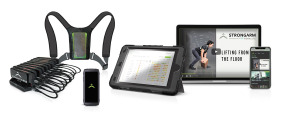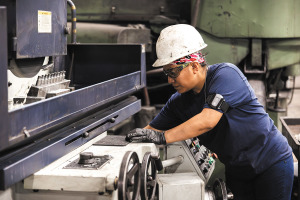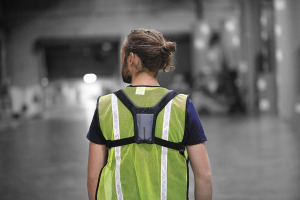Subscriber Benefit
As a subscriber you can listen to articles at work, in the car, or while you work out. Subscribe NowAdapting to Industry 4.0 is often about adding sensors to machinery and collecting data from robots. But it can also mean using sensors to monitor workers—to see not just what they’re doing and how they’re doing it but also whether they are working safely.
Wearable devices that can track locations, motion and environmental factors like temperature, air quality and light are growing in popularity, both in the United States and overseas, according to a smart manufacturing industry survey.
Wisconsin-based Rockwell Automation, which produces devices for use in industrial settings, reports that 81% of more than 1,500 respondents to its annual smart manufacturing survey said they planned to deploy wearables in 2024. And occupational safety and health publication EHS Today has estimated that the wearables industry will spend nearly $3 billion in manufacturing applications alone by the end of this year.
Mitch Landess, vice president of innovation and digital transformation for Conexus Indiana, said workplace wearables can include Google Glass, which is smart eyeware that can let companies see what their workers are seeing, as well as devices that take measurements of a worker’s surroundings to monitor temperature and air quality.
Ergonomic sensors—worn on the hip, back or arm—can alert a user or manager when a worker performs a movement unsafely, such as using improper form when lifting something heavy. That can lead to workers adjusting their actions or managers providing additional training.
Far less common are wearable robots—which can be a type of exoskeleton designed to augment, train or supplement motor functions—and even devices that are implanted or ingested.
Regardless of the way wearable technology is implemented, experts say it can help companies not only monitor workers’ productivity but also protect them and the company’s products.
“It’s about trying to understand capacity utilization, and whether or not the physicality of the tasks they’re performing are overstraining,” Landess said. “What these devices do is create data around that.

“These wearables will let you know when somebody’s spending time in a particularly noisy environment or an area that is not temperature-controlled or if they’re doing a repetitive motion in a way that’s going to cause an [injury] over time.”
But the devices—whether they’re used in the industrial setting or for personal reasons like health and fitness—can also raise concerns as well as questions about data privacy.
A report by the U.S. Government Accountability Office about wearable workforce technology said employees surveyed as a part of a wearable pilot test cited concerns about being tracked. It also said that data stored on wearables could be vulnerable to hackers because updating software can be difficult, and many devices lack strong encryptions.
“As wearables have the potential to collect private information (e.g., work hours, breaks clocked, sleep hours, interests, habits, social circles and even health records), there is little clarity on who actually owns the user data or how they intend to use the data,” four Iowa State University researchers wrote in a study of workplace wearable technology. “The collected information could facilitate bias, prejudice and discriminatory behavior in the workplace. Wearables and mobile computing devices are also prone to security lapses and data breaches.”
Still, the report called the outlook for industrial devices “very promising.”
Reducing injuries, costs
In Argos and Plymouth, manufacturing and machining firm Indiana Technology and Manufacturing Cos. developed a program using Google Glass to assist in the manufacturing process. The company can monitor industrial operations via the wearable device by using the cameras in the eyeware to take photos that can be analyzed by managers or software and used to view the assembly process and worker activity.
And Monticello-based drainage pipe manufacturer Fratco uses a wearable from Des Moines firm MakuSafe to monitor its facility conditions and worker movements. The company learned about the product—worn as an armband—during a meeting of the Wabash Heartland Innovation Network, a network of companies in a 10-county region that is working to deploy internet-connected sensors and promote next-generation manufacturing practices.
Bill Champion, director of operations for Fratco, said the device was first deployed in the company’s Algona, Iowa, facility after extensive employee injuries and workers’ compensation losses. The goal of investing in the system—which is offered as a monthly subscription that includes the devices themselves and the accompanying software—was to reduce safety problems and associated costs.
“We were willing to try about anything, and the [MakuSafe] presentation actually made some sense, even though it had never been on our radar—no wearable had been,” Champion said.
He said injuries and workers’ compensation claims and costs for that facility have drastically declined since the company started using the technology. “There’s no denying the correlation between the wearable and the drastically improved loss experience,” he said.
He said while some Fratco employees expressed skepticism about being monitored, the company has continued to emphasize that the wearables are equally about holding the company accountable for the situations in which it places workers.
“The device [helps] keep the employee aware of practices that might be contributing to an injury or unsafe workplace while at the same time helping us as a company remediate workplace areas and practices that could be contributing to an unsafe work environment,” Champion said.

MakuSafe, which has multiple clients in Indiana, said it does not collect biometric data, such as sweat levels, heart rates or personally identifiable information.

Tom West, vice president of marketing for MakuSafe, said the company’s Ally device “passively” captures data about worker environments. That’s different from some wearables, which monitor specific health metrics from workers to ensure they are not overexerting themselves.
He said data gathered by MakuSafe devices is designed to fold into a company’s existing monitoring systems, rather than requiring companies to buy programs to distill the information.
The MakuSafe devices also track the location of other devices on a network, which helps with contact tracing for illness and monitoring proximity of workers to one another. But West said the devices are not designed to constantly monitor worker locations.
The device also offers a voice memo option, allowing workers to report their own experiences or safety problems at their discretion.
“There is no data that we’re gathering that could be used to hold workers accountable, as the use here is holding the leadership team accountable for solving problems before they happen,” West said. “There are no sensors looking inward at the worker. Instead, they’re looking outward for experiences and exposure. We don’t care how many times you’ve gone to the restroom or how long you’ve been in the break room.
 “What our device is looking for is when work conditions exceed normal thresholds, when something crosses a line into a potential hazard, or when slips, trips or high-force motion are occurring so that we can proactively keep the workers safe.”
“What our device is looking for is when work conditions exceed normal thresholds, when something crosses a line into a potential hazard, or when slips, trips or high-force motion are occurring so that we can proactively keep the workers safe.”
Doing so, as Champion noted, can help reduce workers’ compensation claims and lower insurance premiums. In fact, MakuSafe is a formal partner of Lafayette-based Henriott Group, which provides commercial insurance services.
Zach Finn, director of risk management for Henriott, said the devices are “all about employer accountability” rather than getting workers into trouble.
“That’s absolutely the approach that everybody takes with this, and I think that is the right approach,” he said. “There are certainly productivity gains that come with that. … When you’re improving safety, you’re probably improving productivity pretty dramatically.”
Spreading the word
Finn said as groups like Conexus and the Wabash Heartland Innovation Network continue to inform their members and industry firms about wearables, he expects his and other device companies will be able to benefit—and so, too, will the companies and their employees.
“Indiana is doing some very good things when it comes to fostering use of innovative technologies, including welcoming startup technologies like ours,” he said. “There’s a shift from just being content to write a check for [workers’ compensation] losses to instead looking for solutions and ways to partner with policyholders to predict and prevent claims and incidents and reduce expenses.”

Denver-based StrongArm Technologies, whose device is a vestlike apparatus that places a sensor between the shoulder blades, works with one Indiana manufacturer. StrongArm declined to identify the company, citing a nondisclosure agreement.

Carlos Aviña, senior director of customer success for StrongArm, said the company does not allow its devices to be used for punitive action against employees. Instead, he said, the devices and the data they collect are meant to help streamline discussions between company leaders and what StrongArm calls “industrial athletes” who work in those facilities.
If a human is involved in work, “there’s always going to be a risk of hurting themselves if they don’t have training, and technology … can help bring that [risk] to their attention,” Aviña said.
MakuSafe’s West said he expects more companies to invest in wearables as the industry evolves and more information can be shared with manufacturers and logistics companies. Based on internal surveys, he said, the company’s Ally device has generally improved worker morale and communication between workers and company leadership.
“The market is changing rapidly,” he said. “Technology has caused us to be constantly on this digital transformation journey, both personally and at work. So everybody is in this as a team, and … as long as that conversation is ongoing, we’re seeing that people on the front lines feel better. And scoring is higher on these culture surveys.
“Where there’s a shortage of talent and worker retention, and attraction is as critical as it has ever been, especially in the manufacturing industry,” he said, “this may be a game changer.”•
Please enable JavaScript to view this content.
